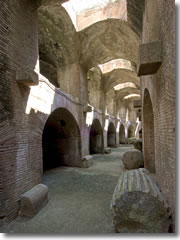- Places
- Plans
- Itineraries
- Experiences

The Tempio di Serapide in Pozzuoli, near Naples, in the Camp Flegrei of CampaniaThough Rome did turn the Greek Parthenope into the thriving Neapolis that became Naples, for a long while the Roman capital of this entire region was not the proto-Naples but rather Puteoli, a Greek colony enlarged to become one of Rome's major trading centers.
With the rise of the port of Ostia at Rome's doorstep, and later Barbarian attacks that led many locals to emigrate to their better-guarded neighbor Naples, Pozzuoli shrank to fishing-village size.
Over the centuries the earthquakes and volcanic eruptions the area is prone to have brought much of the town down and sent its inhabitants scattering, but they always return to rebuild.
Pozzuoli is most famous these days for its excellent fish lunches, having given the world film diva Sophia Loren, and the odd habit the city has of slowly rising, sinking, then rising again in its entirety—an effect called bradyism that is caused by the underlying volcanic activity (the city has risen over 11 feet in the past 30 years).
In a palm-shaded and sunken park at the center of town by the harbor lies the romantically half-flooded "Temple of Serapide." This is not actually a temple as was long believed, but rather the marketplace of the AD 1st-century city, marked by three standing columns and a ring of column stubs surrounding a raised circular dais.
You can see evidence of bradyism at work here: those columns were once further under the water that still pools at the bottom of this archaeological site. The bottom 10 feet of column were buried under the mud of the sea floor (and hence are smooth), the next six feet or so were underwater (hence the pockmarks left by clinging mollusks) and the rest stuck above into clean air (smooth again). The columns (along with the rest of town) probably heaved those 16 feet up during a nearby eruption in 1538.
The site is not open to the public; you just look down at it from the fence.

The underground halls of the Anfiteatro Flavio in Pozzuoli.The Anfiteatro Flavio at Via Terracciano 75 (tel. +39-081-526-6007, cir.campania.beniculturali.it/archeopozzuoli) is one of the oldest amphitheaters in Italy, built under Nero and Vespasian from AD 69-79. During the persecutions of Diocletian in AD 305, it was the site of martyrdom for many a Christian, including Naples beloved San Gennaro.
The exterior is a bit crumbling, and at 149m x 116m it may only rank third in size after the Colosseum at Rome and the nearby amphitheater at Capua (though its seating capacity of 20,000 is nothing to sneeze at)—but unlike Rome's Colosseum, the flooring of the Pozzuoli amphitheater survives.
You can still wander around the tunnels and chambers underneath, where the gladiators once awaited their next fights alongside caged wild beasts. That long trench down the floor's middle, now covered by a grating, was part of the elaborate staging system used to hoist animals and background scenery into view as needed. Today the underground corridors and chambers serve as storage for broken bits of statuary and columns.
The Flavian Amphitheater in Pozzuoli is open Wednesday to Monday, 9am to an hour before sunset (adm).
Pozzuoli has the best array of choices if you plan to stop for lunch, none better sited than Trattoria il Tempio. The umbrella shaded tables are set on the cobblestones directly overlooking the sunken Temple of Serapide at the heart of town. Pozzuoli's seafood is even better than Naples', and there's a prodigious selection of fishy antipasti. If you're not up for the traditional spaghetti alle vongole, try a simple penne al filetto (strips of ripe tomato laid over pasta quills). By all means order their excellent and renowned fresh fish alle brace (grilled) or al forno (baked) for your secondo.
Via Serapide 13. tel. +39-081-526-6519. Open daily lunch and dinner.
Campi Flegrei Tourist Info:
Largo Matteotti 1A, Pozzuoli
tel. +39-081-526-6639
www.infocampiflegrei.it
or
www.coopculture.it
Flavian Amphitheater
Via Terracciano 75
tel. +39-081-526-6007
www.coopculture.it
€4
Pozzuoli is 20 to 40 minutes from Naples—depending on where in Naples you're starting and which form of transport you take:
Luckily, you can get a Unico Napoli ticket for €3.10 that lasts all day and covers pretty much all of this region (of get the Artecard sightseeing pass, detailed below). There's also information on various forms of public transportation on the website: www.unicocampania.it.
To get to Solfatara, take Naples city bus no. 152—from Piazza Garibaldi in Naples; from Via Roma in Pozzuoli—or the CPT bus no. P9 from Pozzuoli's Metro station (tel. +39-081-526-5321, www.ctpn.it).
To get to Baia, take the the Cumana suburban rail line.
To get to Cuma, take the CTP bus no. P12 from Via Roma.
There are two versions of the Campania sightseeing pass that covers this area: Napoli e Campi Flegrei (€16 for three days; 3 sights free, the rest half-off; and all public transport) and Archeologia del Golfo (€30 for 3 days; all sights—including all the ones here [except Solfatara], plus Pompeii, Herculaneum, the Naples Archaeological Museum, and more; and all public transport). Since the sights of the Campi Flegrei are all covered on a single, €4 ticket (except privately-run Solfatara, which costs another €6), if you get that first pass I'd actually use the 3 freebies for pricier marquee sights in Naples—but you still get 50% off your Phlegrean Fields ticket, plus that invaluable free bus/Metro pass. For details: www.campaniartecard.it.
Share this page
Search ReidsItaly.com
Campi Flegrei Tourist Info:
Largo Matteotti 1A, Pozzuoli
tel. +39-081-526-6639
www.infocampiflegrei.it
or
www.coopculture.it
Flavian Amphitheater
Via Terracciano 75
tel. +39-081-526-6007
www.coopculture.it
€4